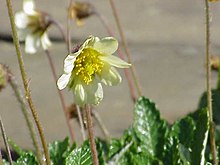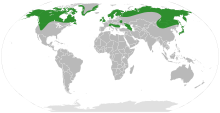| Dryas | |
|---|---|

| |
| Dryas × suendermannii | |
| Scientific classification | |
| Kingdom: | Plantae |
| Clade: | Tracheophytes |
| Clade: | Angiosperms |
| Clade: | Eudicots |
| Clade: | Rosids |
| Order: | Rosales |
| Family: | Rosaceae |
| Subfamily: | Dryadoideae |
| Genus: | Dryas L. |
| Species | |
|
See text | |

| |
| Synonyms[1] | |
| |
Dryas is a genus of perennial cushion-forming evergreen dwarf shrubs in the family Rosaceae, native to the arctic and alpine regions of Europe, Asia and North America. The genus is named after the dryads, the tree nymphs of ancient Greek mythology. The classification of Dryas within the Rosaceae has been unclear.[2][3] The genus was formerly placed in the subfamily Rosoideae, but is now placed in subfamily Dryadoideae.[4]
The species are superficially similar to Geum (with which they share the common name avens), Potentilla, and Fragaria (strawberry). However, Dryas are distinct in having flowers with eight petals (rarely seven or up to ten), instead of the five petals found in most other genera in the Rosaceae. The flowers are erect and white with a yellow centre (Dryas integrifolia, Dryas octopetala) or pendulous and all-yellow (Dryas drummondii), and held conspicuously above the small plants. This makes them very popular in rockeries and alpine gardens. The hybrid Dryas × suendermannii, with cream coloured flowers, has gained the Royal Horticultural Society's Award of Garden Merit.[5][6]
Dryas tolerates a wide variety of unshaded habitats, including alpine situations with sand or gravel substrate, similar substrates in flat tundra lowlands, and also fen habitats upon organic substrate where some shading from adjacent sedges or shrubs may occur.
The Younger Dryas and Older Dryas stadials are geological periods of cold temperature that are named after Dryas octopetala, which flourished during that time and is used as a fossil indicator of those periods.[citation needed][7]
- ^ Govaerts R. "Dryas L." Plants of the World Online. Board of Trustees of the Royal Botanic Gardens, Kew. Retrieved 14 December 2020.
- ^ Morgan DR, Soltis DE, Robertson KR (1994). "Systematic and evolutionary implications of rbcL sequence variation in Rosaceae". Am J Bot. 81 (7): 890–903. doi:10.2307/2445770. JSTOR 2445770..
- ^ Eriksson, Torsten; et al. (2003), "The Phylogeny of Rosoideae (Rosaceae) Based on Sequences of the Internal Transcribed Spacers (ITS) of Nuclear Ribosomal DNA and the trnL/F Region of Chloroplast DNA" (PDF), International Journal of Plant Sciences, 164 (2): 197, doi:10.1086/346163, S2CID 22378156
- ^ Potter D, Eriksson T, Evans RC, Oh S, Smedmark JEE, Morgan DR, Kerr M, Robertson KR, Arsenault M, Dickinson TA, Campbell CS (2007). "Phylogeny and classification of Rosaceae". Plant Systematics and Evolution. 266 (1–2): 5–43. doi:10.1007/s00606-007-0539-9. S2CID 16578516..
- ^ "RHS Plantfinder - Dryas × suendermannii".
- ^ "AGM Plants - Ornamental" (PDF). Royal Horticultural Society. July 2017. p. 33. Retrieved 24 January 2018.
- ^ Connor, Simon E.; Kvavadze, Eliso V. (2009). "Modelling late Quaternary changes in plant distribution, vegetation and climate using pollen data from Georgia, Caucasus". Journal of Biogeography. 36 (3): 529–545. doi:10.1111/j.1365-2699.2008.02019.x. hdl:11343/55209. S2CID 83949372.